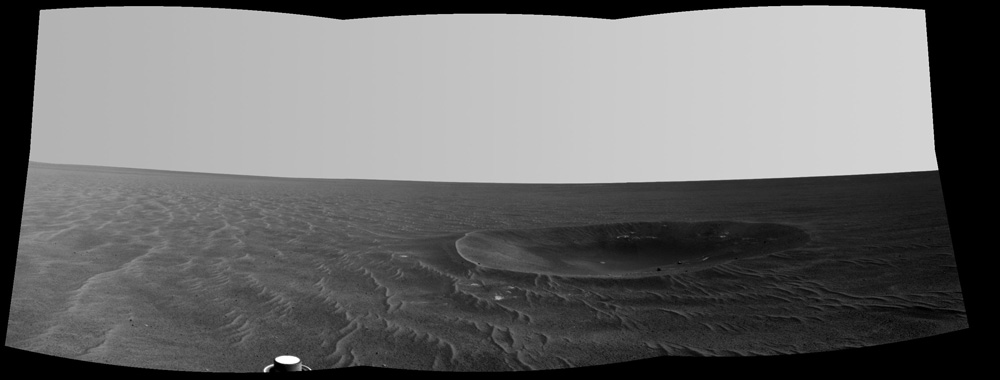Mars Craters Named After NASA's Apollo 12 Moonships

Two Mars craters photographed by NASA's Opportunity rover have received new names to honor the historic Apollo 12 spaceships that carried humans on the second flight to land on the moon.
The craters, which Opportunity has visited this month, are called "Yankee Clipper" and "Intrepid" – the same designations for the Apollo 12 mission's command module and lunar lander during their November 1969 mission to the moon, NASA officials have announced.
During the Apollo 12 lunar landing mission, astronauts Pete Conrad and Alan Bean touched down on the moon in their lander, Intrepid, on Nov. 19, 1969, while crewmate Dick Gordon remained in lunar orbit aboard the command module Yankee Clipper. The mission occurred four months after the first manned lunar landing mission – Apollo 11 - in July 1969.
In a message to NASA's Mars rover team, Bean – now 78 – told the rover team that it was a "wonderful honor" to have Mars craters named after the Apollo 12 spacecraft.
"Forty-one years ago today, we were approaching the moon in Yankee Clipper with Intrepid in tow. We were excited to have the opportunity to perform some important exploration of a place in the universe other than planet Earth where humans had not gone before," Bean said in a Nov. 18 statement. "We were anxious to give it our best effort. You and your team have that same opportunity. Give it your best effort."
Opportunity drove past the crater Yankee Clipper on Nov. 4 and arrived at the Intrepid crater on Nov. 9. The Yankee Clipper crater is about 33 feet (10 meters) wide, while Intrepid crater is twice that size.
The idea to name the craters after the Apollo 12 spacecraft came from rover science team member James Rice, NASA officials said.
Breaking space news, the latest updates on rocket launches, skywatching events and more!
"The Apollo missions were so inspiring when I was young, I remember all the dates," Rice said in a statement. "When we were approaching these craters, I realized we were getting close to the Nov. 19 anniversary for Apollo 12."
Rice sent Bean and Gordon – the living members of the Apollo 12 crew – photographs that Opportunity took of the two craters. Gordon is 81. Conrad died 1999 at age 69 in a motorcycle accident.
Opportunity photographed the Yankee Clipper and Intrepid craters while driving toward an even larger crater called Endeavour. That behemoth of a Mars crater is about 14 miles (22 km) wide, mission scientists have said.
Opportunity and its robotic twin Spirit have been exploring Mars since both rovers landed on the Red Planet in January 2004.
The robots were initially slated to perform a 90-day mission, but have far outlasted their expected Martian lifetimes. The mission is overseen by NASA's Jet Propulsion Laboratory in Pasadena, Calif.
Last year, Spirit got bogged down in deep sand and was later rechristened as a stationary probe. The probe has been silent since late March, presumably hibernating through the Martian winter, until sunlight levels increase enough to resume operations on Mars, NASA officials have said. The Martian spring began last week, they added.
Meanwhile, Opportunity has been making steady progress toward Endeavour crater.
On Nov. 14, Opportunity's odometer passed the 25-kilometer mark (about 15.53 miles). That's about 40 times the distance Mars scientists expected the rovers to drive, NASA officials said.
"Importantly, it's not how far the rovers have gone but how much exploration and science discovery they have accomplished on behalf of all humankind," said John Callas, NASA's Mars rover project manager at JPL.

Space.com is the premier source of space exploration, innovation and astronomy news, chronicling (and celebrating) humanity's ongoing expansion across the final frontier. Originally founded in 1999, Space.com is, and always has been, the passion of writers and editors who are space fans and also trained journalists. Our current news team consists of Editor-in-Chief Tariq Malik; Editor Hanneke Weitering, Senior Space Writer Mike Wall; Senior Writer Meghan Bartels; Senior Writer Chelsea Gohd, Senior Writer Tereza Pultarova and Staff Writer Alexander Cox, focusing on e-commerce. Senior Producer Steve Spaleta oversees our space videos, with Diana Whitcroft as our Social Media Editor.

